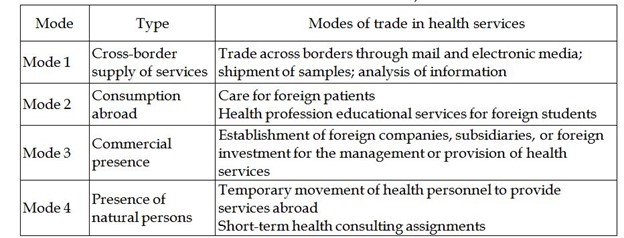The new future of medical tourism is emerging, quickly in some markets and slowly in others, and will not look anything like what has been known up to now as “medical tourism”, says Irving Stackpole, President, Stackpole & Associates.
The future for medical tourism needs to be understood in the context of the Modes of cross-border trade in health services, defined by the World Trade Organization’s General Agreement on Trade in Services (GATS).

Until recently, traditional medical tourism providers have focused only on Mode 2, where the consumer travels across a border in order to receive services in another country. The other modes of cross-border trade are now growing in importance.
The development of medical tourism has relied on an opportunistic business model; think “pop up” clinics for everything from Botox to Ayurveda, hair transplants to weight loss surgery. This opportunism attracted businesses and individuals who may not have had lasting commitment or relevant experience. But more stable foundations are being built, including commitments to access, knowledge and skills transfer, digital healthcare and workforce development.
From opportunistic to sustainable
The old model of medical tourism is vulnerable. The pandemic closed down commercial air traffic. There was a drastic reduction of the number of flights around the world; even today some historically robust travel corridors have not returned to their pre-pandemic levels. This exposed a significant vulnerability in the old medical tourism model.
Another vulnerability is the growing recognition of the damage to the environment from air traffic. Climate change and global warming are top of mind and will remain so for some time. The carbon footprint of one person getting on a commercial airliner and travelling to another location for health, wellness or even some medical services is getting more difficult to defend.
Our hybrid future
The hybrid future for health and medical tourism integrates many Modes of GATS trade. In other words, a combination of remote digital healthcare, professionals travelling rather than the consumers, as well as in-person physical access. This mixture of Modes is the hybrid future for medical tourism.
Episodes and Mixed Modes
The provision of medical, dental and other types of healthcare usually happen over a period of time in three distinct steps. The initial step to treatment is always diagnosis. Once a diagnosis is made, a treatment plan is drawn up and then the actual services or treatments are provided to and consumed by the individual/patient. Following treatment there is often a period of recovery and/or rehabilitation. Sometimes these time periods are lengthy and other times are quite short.
In a hybrid model, the diagnosis might occur remotely, with the medical professional team in one location while the consumer is in another location. Telehealth/telemedicine diagnostics and the digital transfer of health records and other information enable this type of remote diagnosis. The pandemic has accelerated the growth of telehealth and remote diagnostic services, including second surgical opinion programmes.
Following diagnosis, the second step might be in-person treatment in a location across the border from where the patient lives. This is the traditional, GATS Mode 2, component of medical tourism where the customer travels to the provider.
One of the weakest links for the “old” medical tourism model has been recuperation or rehabilitation following surgery or treatment. When someone travels for treatment and then returns home, complications can arise, and the original medical team may not even know. In a truly hybrid environment using remote patient monitoring, the clinical team responsible for the treatment can monitor the progress of the patient in their residential location. If further evaluation or even treatment is needed, the treating medical team are in a much better position to communicate with the patient’s local medical team.
Through effective remote patient monitoring (RPM), this hybrid model limits the need of the consumer to travel from one location to another and may eliminate the travel altogether. These RPM digital tools can be applied to assure recovery, and to reassure patients and their families.
Risks to the hybrid future
To be successful, what a new hybrid model needs is harmonised standards of practice across borders. The cross-border use of healthcare professionals in one location requires, for example, that the malpractice and other regulations in another location is on the same page. If a doctor in one country is not allowed to prescribe or manage the care of a patient in another country, this model runs into significant difficulties.
But the weakest link of all is having an available workforce to provide the services. One of the stark realities that the pandemic has taught us is that nurses, allied health professionals, and doctors are not an endless supply. In many locations these critical workers are in declining numbers, and very important steps need to be taken in order to reinforce the supply.
One of the opportunities in cross-border trade markets is to find people in other destinations and train them to acquire necessary skills. It may be easier for example to move a few radiological technologists than it is to transport hundreds or thousands of patients for X-Rays or MRIs. In the GATS framework this represents another Mode of cross-border trade, Mode 4. Whenever or wherever workforce is in short supply, it may be more efficient to train workforce to serve the high demand population in other locations.
All three of these Modes of cross-border trade – Mode 2, where the consumer travels abroad, Mode 1 where the information travels across the border rather than the consumer, and Mode 4 where trained professionals travel in order to deliver services – are now being blended into the new hybrid market of medical tourism.
About the author
Irving Stackpole is President of Stackpole & Associates, Inc., a consultancy which applies scientific marketing principles to find intelligent answers and practical solutions in healthcare, long term care, seniors’ housing and services, and medical travel. Email: [email protected]








 ©2024 All rights reserved LaingBuisson
©2024 All rights reserved LaingBuisson 


